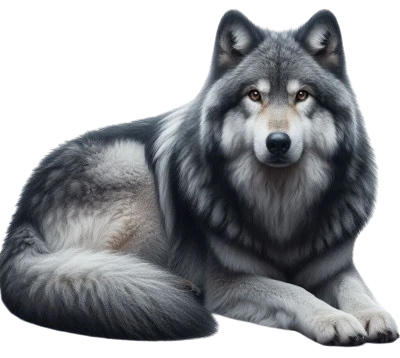Manchurian Wolf: Lord of the Asian Steppes
The Manchurian Wolf (Canis lupus chanco) is a rare subspecies of gray wolf native to the forested and steppe regions of East Asia. It plays a key role in maintaining the ecological balance of its habitat.
Physical Description of the Dog
The Manchurian Wolf is slightly smaller than the typical gray wolf, with an average shoulder height of 50 to 70 cm and a weight ranging from 20 to 35 kg. Its thick coat, primarily light gray with yellowish and white highlights, provides protection against the extreme temperatures of its habitat. Its robust appearance is accentuated by short ears and a compact muzzle.
Classification
This subspecies is classified as follows:
- Kingdom: Animalia (Animals)
- Phylum: Chordata (Chordates)
- Class: Mammalia (Mammals)
- Order: Carnivora (Carnivores)
- Family: Canidae (Canids)
- Genus: Canis
- Species: Canis lupus
- Subspecies: Canis lupus chanco
Habitat
The Manchurian Wolf is mainly found in mixed forests, grasslands, and mountainous regions of northeastern China, Manchuria, and the Korean Peninsula. These ecosystems provide an ideal combination of cover and prey.
Behavior and Social Life
This subspecies is often solitary or lives in small family groups. Although less social than other wolves, they maintain hierarchical structures within their group. Their diet is varied, including deer, wild boars, and small mammals.
Conservation
The Manchurian Wolf is classified as "Near Threatened" due to habitat loss, poaching, and conflicts with local herders. Targeted conservation efforts are essential to ensure its survival.
Closest Genetic Cousins
The Manchurian Wolf belongs to the genus Canis, which also includes the Gray Wolf (Canis lupus), the Coyote (Canis latrans), and the Golden Jackal (Canis aureus). These species share common characteristics, such as their pack social structure and cooperative hunting behaviors.
-
The Gray Wolf is one of the closest genetic cousins of the Manchurian Wolf. It is widely distributed across the Northern Hemisphere, with a wide variety of subspecies adapted to different environments. The Gray Wolf is known for its ability to adapt to various habitats, ranging from forests to tundras.
-
The Coyote is another member of the genus Canis that shares genetic similarities with the Manchurian Wolf. Native to North America, the Coyote is an opportunistic and adaptable animal, capable of living in a variety of habitats, including urban areas.
-
The Golden Jackal is a smaller species but genetically close to the Manchurian Wolf. It is primarily found in Africa, Asia, and Southeastern Europe. The Golden Jackal is known for its ability to survive in diverse environments, ranging from deserts to forests.
Tips for Observers
Observing the Manchurian Wolf in its natural habitat can be a fascinating experience, but it is essential to do so respectfully and discreetly. Here are some tips:
- Get informed: Learn about the protected areas and ecological characteristics of the Manchurian Wolf before setting out on an expedition.
- Keep your distance: Avoid disturbing these wild animals by observing them from a distance with binoculars or a telephoto lens.
- Respect the environment: Leave no trace of your presence and follow local conservation rules.
- Travel with a guide: It is advisable to travel with an experienced guide to maximize your chances of seeing a wolf while respecting conservation principles.
By following these precautions, you contribute to preserving the Manchurian Wolf and its fragile environment.
The Manchurian Wolf is a vital predator in its ecosystem. Protecting this subspecies helps preserve the unique biodiversity of East Asia.
Wild Dog Breeds
© 2023 touslestoutous.com − All doggies. All rights reserved.
"The data available on this site may be used provided that the source is duly acknowledged."
